Concurrency is not Parallelism
Waza Jan 11, 2012
Rob Pike
Rob Pike
This talk was presented at Heroku's Waza conference in January 2012.
2Multicore.
Networks.
Clouds of CPUs.
Loads of users.
Our technology should help.
That's where concurrency comes in.
Go provides:
NO! A fallacy.
When Go was announced, many were confused by the distinction.
"I ran the prime sieve with 4 processors and it got slower!"
5Programming as the composition of independently executing processes.
(Processes in the general sense, not Linux processes. Famously hard to define.)
6Programming as the simultaneous execution of (possibly related) computations.
7Concurrency is about dealing with lots of things at once.
Parallelism is about doing lots of things at once.
Not the same, but related.
Concurrency is about structure, parallelism is about execution.
Concurrency provides a way to structure a solution to solve a problem that may (but not necessarily) be parallelizable.
8Concurrent: Mouse, keyboard, display, and disk drivers.
Parallel: Vector dot product.
9Concurrency is a way to structure a program by breaking it into pieces that can be executed independently.
Communication is the means to coordinate the independent executions.
This is the Go model and (like Erlang and others) it's based on CSP:
C. A. R. Hoare: Communicating Sequential Processes (CACM 1978)
10This is too abstract. Let's get concrete.
11Move a pile of obsolete language manuals to the incinerator.
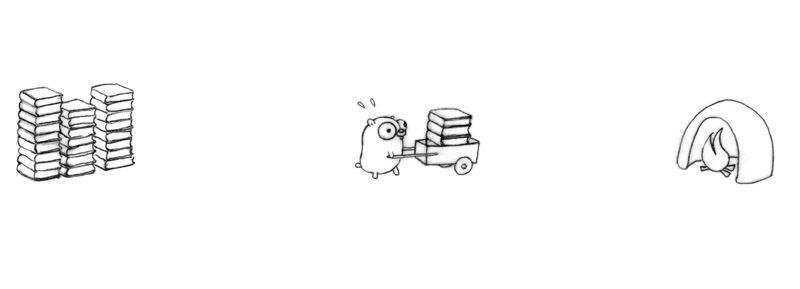
With only one gopher this will take too long.
12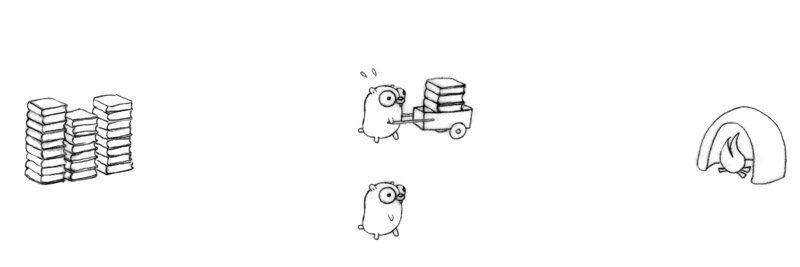
More gophers are not enough; they need more carts.
13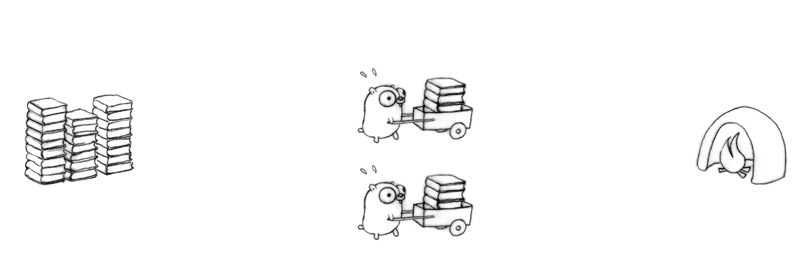
This will go faster, but there will be bottlenecks at the pile and incinerator.
Also need to synchronize the gophers.
A message (that is, a communication between the gophers) will do.
Remove the bottleneck; make them really independent.
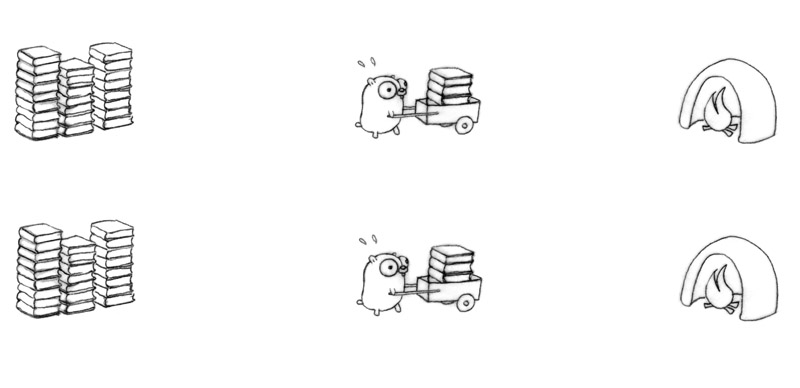
This will consume input twice as fast.
15
The concurrent composition of two gopher procedures.
16This design is not automatically parallel!
What if only one gopher is moving at a time?
Then it's still concurrent (that's in the design), just not parallel.
However, it's automatically parallelizable!
Moreover the concurrent composition suggests other models.
17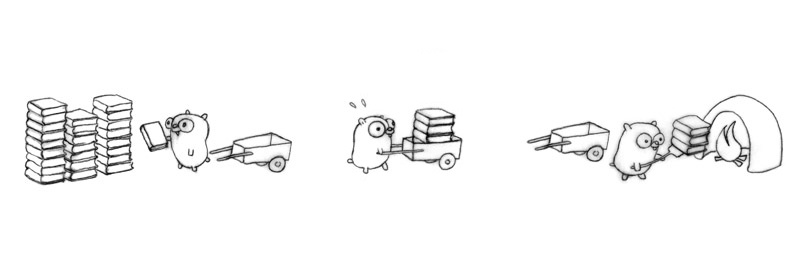
Three gophers in action, but with likely delays.
Each gopher is an independently executing procedure,
plus coordination (communication).
Add another gopher procedure to return the empty carts.
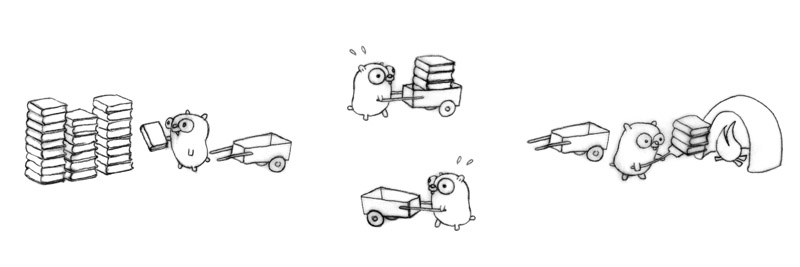
Four gophers in action for better flow, each doing one simple task.
If we arrange everything right (implausible but not impossible), that's four times faster than our original one-gopher design.
19We improved performance by adding a concurrent procedure to the existing design.
More gophers doing more work; it runs better.
This is a deeper insight than mere parallelism.
20Four distinct gopher procedures:
Different concurrent designs enable different ways to parallelize.
21We can now parallelize on the other axis; the concurrent design makes it easy. Eight gophers, all busy.
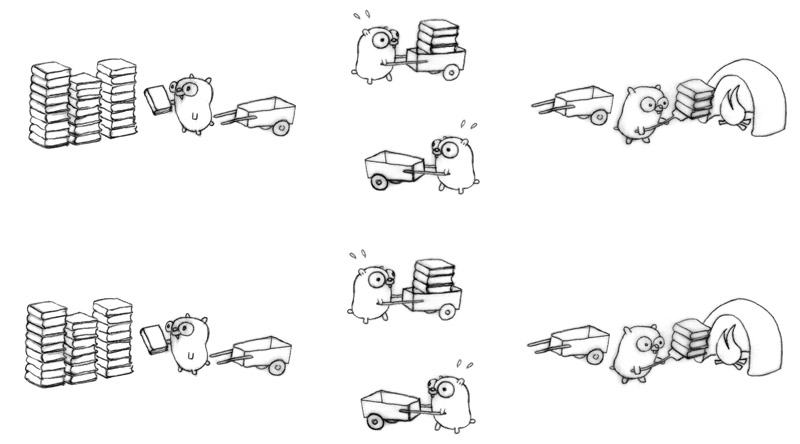
Keep in mind, even if only one gopher is active at a time (zero parallelism), it's still a correct and concurrent solution.

Here's another way to structure the problem as the concurrent composition of gopher procedures.
Two gopher procedures, plus a staging pile.
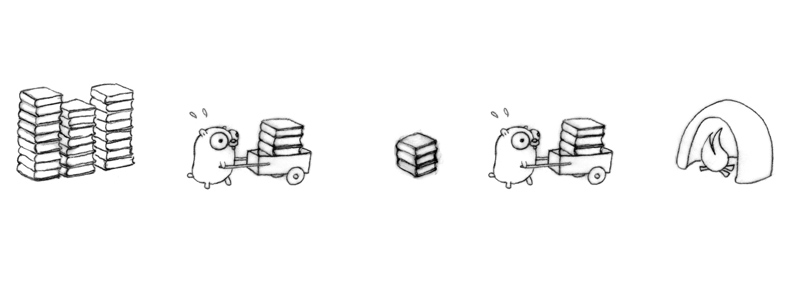
Run more concurrent procedures to get more throughput.
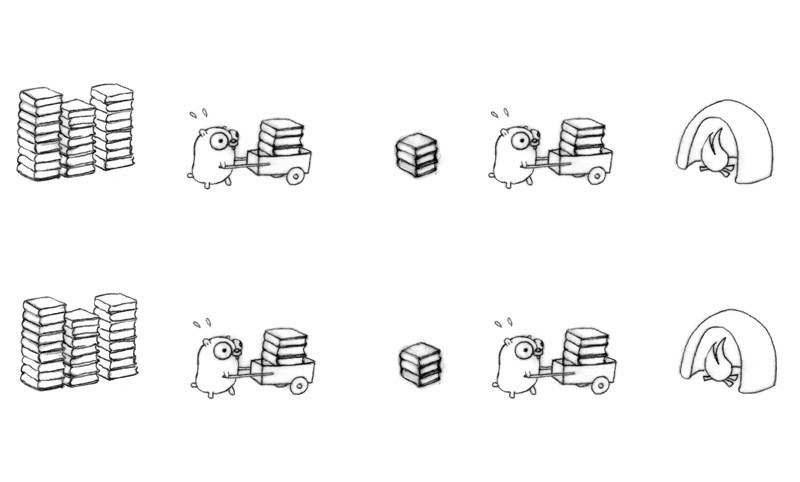
Bring the staging pile to the multi-gopher concurrent model:

Use all our techniques. Sixteen gophers hard at work!
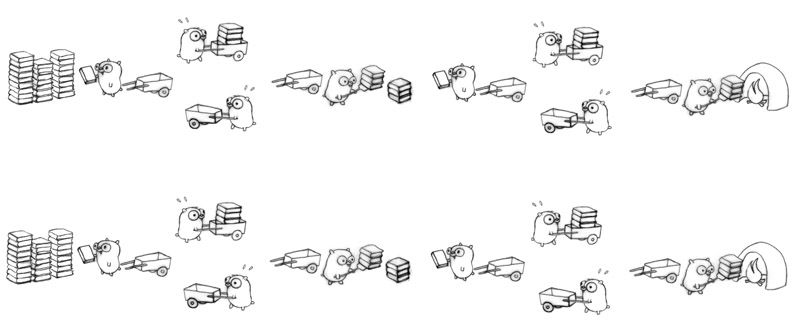
There are many ways to break the processing down.
That's concurrent design.
Once we have the breakdown, parallelization can fall out and correctness is easy.
28In our book transport problem, substitute:
It becomes a concurrent design for a scalable web service.
Gophers serving web content.
Not the place for a tutorial, just quick highlights.
30A goroutine is a function running independently in the same address space as other goroutines
f("hello", "world") // f runs; we wait
go f("hello", "world") // f starts running g() // does not wait for f to return
Like launching a function with shell's & notation.
(They're a bit like threads, but they're much cheaper.)
Goroutines are multiplexed onto OS threads as required.
When a goroutine blocks, that thread blocks but no other goroutine blocks.
32Channels are typed values that allow goroutines to synchronize and exchange information.
timerChan := make(chan time.Time) go func() { time.Sleep(deltaT) timerChan <- time.Now() // send time on timerChan }() // Do something else; when ready, receive. // Receive will block until timerChan delivers. // Value sent is other goroutine's completion time. completedAt := <-timerChan
The select statement is like a switch, but the decision is based on ability to communicate rather than equal values.
select { case v := <-ch1: fmt.Println("channel 1 sends", v) case v := <-ch2: fmt.Println("channel 2 sends", v) default: // optional fmt.Println("neither channel was ready") }
Really.
It's routine to create thousands of goroutines in one program.
(Once debugged a program after it had created 1.3 million.)
Stacks start small, but grow and shrink as required.
Goroutines aren't free, but they're very cheap.
35Make some concurrent calculations easier to express.
They are just local functions.
Here's a non-concurrent example:
func Compose(f, g func(x float) float) func(x float) float { return func(x float) float { return f(g(x)) } } print(Compose(sin, cos)(0.5))
Learn concurrent Go by osmosis.
37Use a closure to wrap a background operation.
This copies items from the input channel to the output channel:
go func() { // copy input to output for val := range input { output <- val } }()
The for range operation runs until channel is drained.
A unit of work:
type Work struct { x, y, z int }
A worker task
func worker(in <-chan *Work, out chan<- *Work) { for w := range in { w.z = w.x * w.y Sleep(w.z) out <- w } }
Must make sure other workers can run when one blocks.
40The runner
func Run() { in, out := make(chan *Work), make(chan *Work) for i := 0; i < NumWorkers; i++ { go worker(in, out) } go sendLotsOfWork(in) receiveLotsOfResults(out) }
Easy problem but also hard to solve concisely without concurrency.
41The load balancer is implicitly parallel and scalable.
NumWorkers could be huge.
The tools of concurrency make it almost trivial to build a safe, working, scalable, parallel design.
42No explicit synchronization needed.
The structure of the program is implicitly synchronized.
43Let's do a more realistic load balancer.
44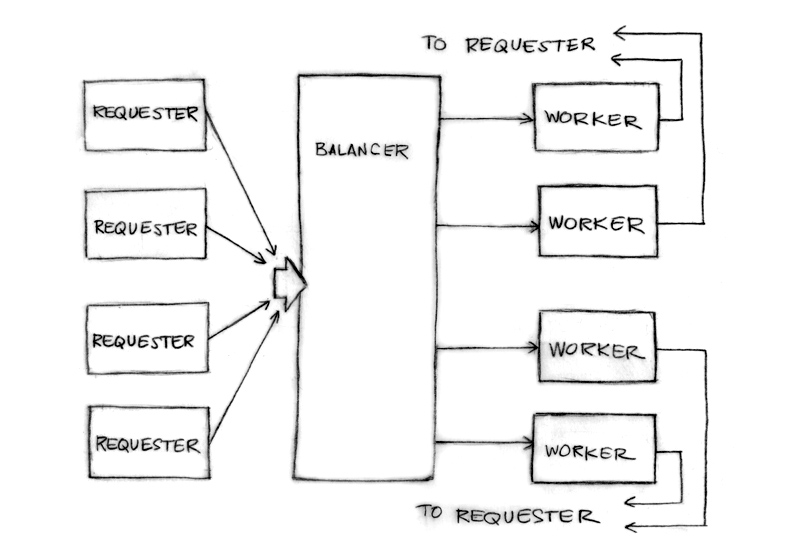
The requester sends Requests to the balancer
type Request struct { fn func() int // The operation to perform. c chan int // The channel to return the result. }
Note the return channel inside the request.
Channels are first-class values.
An artificial but illustrative simulation of a requester, a load generator.
func requester(work chan<- Request) { c := make(chan int) for { // Kill some time (fake load). Sleep(rand.Int63n(nWorker * 2 * Second)) work <- Request{workFn, c} // send request result := <-c // wait for answer furtherProcess(result) } }
A channel of requests, plus some load tracking data.
type Worker struct { requests chan Request // work to do (buffered channel) pending int // count of pending tasks index int // index in the heap }
Balancer sends request to most lightly loaded worker
func (w *Worker) work(done chan *Worker) { for { req := <-w.requests // get Request from balancer req.c <- req.fn() // call fn and send result done <- w // we've finished this request } }
The channel of requests (w.requests) delivers requests to each worker. The balancer tracks the number of pending requests as a measure of load.
Each response goes directly to its requester.
Could run the loop body as a goroutine for parallelism.
49The load balancer needs a pool of workers and a single channel to which requesters can report task completion.
type Pool []*Worker type Balancer struct { pool Pool done chan *Worker }
Easy!
func (b *Balancer) balance(work chan Request) { for { select { case req := <-work: // received a Request... b.dispatch(req) // ...so send it to a Worker case w := <-b.done: // a worker has finished ... b.completed(w) // ...so update its info } } }
Just need to implement dispatch and completed.
51
Make Pool an implementation of the Heap interface by providing a few methods such as:
func (p Pool) Less(i, j int) bool { return p[i].pending < p[j].pending }
Now we balance by making the Pool a heap tracked by load.
All the pieces are in place.
// Send Request to worker func (b *Balancer) dispatch(req Request) { // Grab the least loaded worker... w := heap.Pop(&b.pool).(*Worker) // ...send it the task. w.requests <- req // One more in its work queue. w.pending++ // Put it into its place on the heap. heap.Push(&b.pool, w) }
// Job is complete; update heap func (b *Balancer) completed(w *Worker) { // One fewer in the queue. w.pending-- // Remove it from heap. heap.Remove(&b.pool, w.index) // Put it into its place on the heap. heap.Push(&b.pool, w) }
A complex problem can be broken down into easy-to-understand components.
The pieces can be composed concurrently.
The result is easy to understand, efficient, scalable, and correct.
Maybe even parallel.
55We have a replicated database and want to minimize latency by asking them all and returning the first response to arrive.
56func Query(conns []Conn, query string) Result { ch := make(chan Result, len(conns)) // buffered for _, conn := range conns { go func(c Conn) { ch <- c.DoQuery(query): }(conn) } return <-ch }
Concurrent tools and garbage collection make this an easy solution to a subtle problem.
(Teardown of late finishers is left as an exercise.)
57Concurrency is powerful.
Concurrency is not parallelism.
Concurrency enables parallelism.
Concurrency makes parallelism (and scaling and everything else) easy.
58Go: golang.org
Some history: swtch.com/~rsc/thread/
A previous talk (video): tinyurl.com/newsqueak1
Parallelism is not concurrency (Harper): tinyurl.com/pincharper
A concurrent window system (Pike): tinyurl.com/pikecws
Concurrent power series (McIlroy): tinyurl.com/powser
And finally, parallel but not concurrent:
research.google.com/archive/sawzall.html
Rob Pike